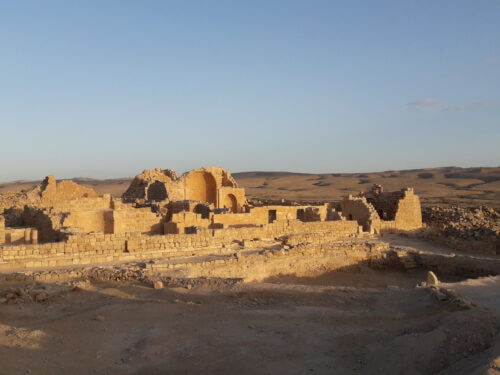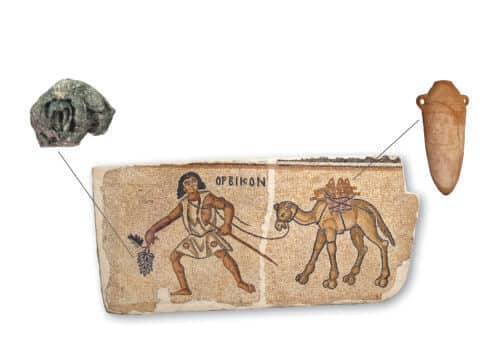The researchers: Justinian's plague and climate change - reveal weaknesses of economic and political systems then and now. The difference is that the Byzantines did not see what was coming. We can already prepare for the next epidemic outbreaks and the impending consequences of climate change. The question is, will we be able to do it?

It is possible that an ancient world shock in the form of an epidemic also affected the economy of the Land of Israel in the 6th century CE, according to a new study by archaeologists from Bar Ilan University, Haifa University, Tel Aviv University and the Antiquities Authority, published these days in the prestigious journal of American Academy of Sciences (PNAS).
The research showed for the first time empirical evidence of the existence and decline of a commercial vine branch in the middle of the desert about 1,500 years ago! This branch began to develop in the 4th century AD and reached its peak in the middle of the 6th century, according to the research.
As we all try to make sense of the new reality created by the coronavirus, many are looking back to historical precedents for major pandemics, including the 1918 flu pandemic and the Black Thing of the 14th century. The first wave known in our regions of the Black Thing virus struck in 541 AD throughout the Byzantine Empire and beyond. This epidemic - known as the Justinian plague after the Byzantine emperor who contracted the virus but survived - caused a terrible death toll and a variety of economic and social effects.
Daniel Fox, a PhD student in Bar-Ilan's Department of AI Studies and Archaeology, led the research as a research student in the Archaeological Botany Laboratory of Prof. Ehud Weiss and as a partner in the Byzantine Negev Project managed by Prof. Guy Bar-Oz of Haifa University. The Negev Byzantine Project seeks to find out when and why the ancient agricultural settlement in the Negev Mountains was abandoned - a settlement based on runoff agriculture that reached its peak during the Byzantine period at sites such as Shveta, Nitsana Halutza, Abdat, Saadon, Rehovot-Bangev and Mashit. The visitor to the Negev Mountain sites today will see the evidence of their past glory in beautiful stone buildings, but the Bar-Oz team, under the guidance of archaeologists from the Antiquities Authority, Dr. Yotam Teper and Dr. Tali Erickson-Gini, found more impressive evidence in a less expected place: the garbage. It turns out that the trash reveals a lot about the people who threw it away. "In the garbage heaps of the ancient Negev sites we found a rich record of the daily life of the inhabitants - including pottery, animal bones and plant remains," explains Bar-Oz. "In the Byzantine Negev project, we dug up piles of garbage to discover the human activity behind the garbage, when it flourished, from what, and when it declined."
The study of seeds that are discovered in archaeological excavations belongs to a field of research called "archaeological botany". The head of the Archaeological Botany Laboratory in Bar-Ilan, Prof. Weiss, explains that the role of archaeological botany is to "go into the pantry - or in this case, the garbage can - of people who lived in the past and investigate their use of plants. Archaeological botany reconstructs an ancient economy, environment and culture, but the road there is not easy. One has to go grain by grain out of quantities of sediment in order to extract the precious seeds - as it is said, '...if a man can number the dust of the earth, his seed will also be numbered' (Genesis 10,000:11)". In the current case, it is about XNUMX vine, wheat and barley seeds that were removed from XNUMX garbage heaps in Chalutza, Shveta and Nitsana. "The ability to define this find is unique to our laboratory," says Prof. Weiss, "and it is based on the national seed collection found in our laboratory, and on years of experience in processing finds from excavation sites throughout all periods in the Land of Israel."

One of the first observations of the researchers was that in the ancient landfills there are many grape vines. This finding corresponds to the suggestions of previous researchers that the Negev was a source of growing grapes for export. Byzantine texts praise "Gaza wine" - a sweet white wine that is exported from the ancient port in Gaza to the vastness of the empire and beyond. This wine comes out mainly in designated jugs, "Gaza jugs" which were also found in relatively high frequency in the garbage of the Byzantine Negev mountain, as well as in cities of the period from Britain to Yemen.
Daniel wanted to check if there were any interesting patterns for the relative prevalence of the vine in the dung to trace the development of the early economic industry:
"Imagine that you are a farmer of old with an area of land that is enough to support a family. In most of the area you sow grain, because bread is made from it. On a small plot you plant a vineyard and fruit trees, and sow a variety of legumes and vegetables.
But one day you realize that it is possible to sell your fine wine, along with the other members of the settlement, to the export market. Little by little, you enlarge the vineyard and move from a subsistence interface to a commercial one.
If we look in your manure and count the seeds, we will find an increase in the ratio between the vine weevils and the grain grains.
This is exactly what we discovered: a significant increase in the relative prevalence of vine borers between the 4th century and the middle of the 6th century. And then suddenly there is a significant drop."
Daniel and Dr. Tali Erickson-Gini, an expert on ancient pottery, took this discovery one step further. They checked if there are parallel patterns in the relative frequency of the designated "Gaza jugs", which are more suitable for transport on a camel from the Negev Mountains to the port in Gaza, in relation to "sack jugs" - a jug is less suitable for this. The two discovered that the rise and fall of the Gaza jars in the Negev Mountains corresponded to the rise and fall of the vine. From this the researchers concluded that the Negev's commercial vine industry was related to the Mediterranean trade. That is, it is a testimony to an international commercial economy from about 1500 years ago. As today, this situation resulted in unprecedented economic prosperity, but also greater vulnerability to shocks.
In the middle of the 6th century there were several shocks that could explain the decline, the researchers write. One of them is the Justinian plague which killed a significant part of the population. In the article, the researchers explain that a 20% drop in demand following the deaths in the first wave of the epidemic was enough to leave the Negev out of the picture, even if trade in Gaza wine continued on the coastal plain. If the epidemic reached the Negev, it would affect the supply by decreasing the availability of agricultural workers.
Another shock that occurred at that time was a volcanic eruption at the end of 535 or the beginning of 536 CE, which covered the atmosphere with dust and caused global cooling (a volcano on a similar scale also erupted in 539 CE). This phenomenon caused a drought in Europe but probably heavy rains in our regions (similar to the rains of 1992 following the eruption of the Pinatubo volcano in the Philippines).
The research raises new insights and shows an impressive wisdom in the ancients, from the study of the ancient plants. Prof. Guy Bar-Oz, head of the research group of the Byzantine Negev, says: "The discovery of the rise and fall of the early commercial vine branch in the Negev joins other discoveries of our research project on decline in the middle of the 6th century. The decline came close to a century before the Islamic conquest. It seems that the agricultural settlement in the Negev suffered such a strong blow that it did not recover until modern times."
The two leading options for the shock factor - epidemic and climate change - reveal weaknesses of economic and political systems then and now. "The difference is that the Byzantines did not see what was coming," explains Daniel. "We can already prepare for the next epidemic outbreaks and the impending consequences of climate change. The question is, will we be able to do it?"

One response
Please move disabled sign to a place that does not hide text.
For the Corona epidemic - over the head of the owner of Midina and his approval.
He came to end the reign of a carnivorous religion with idle occupations